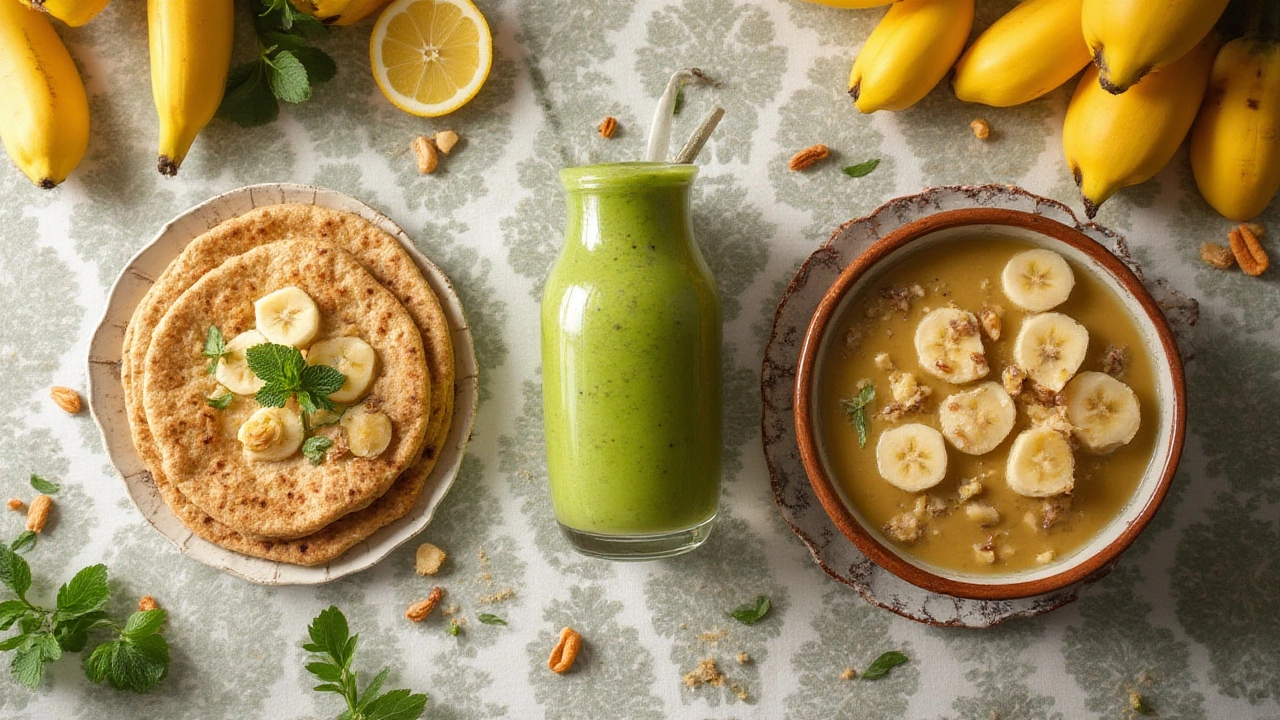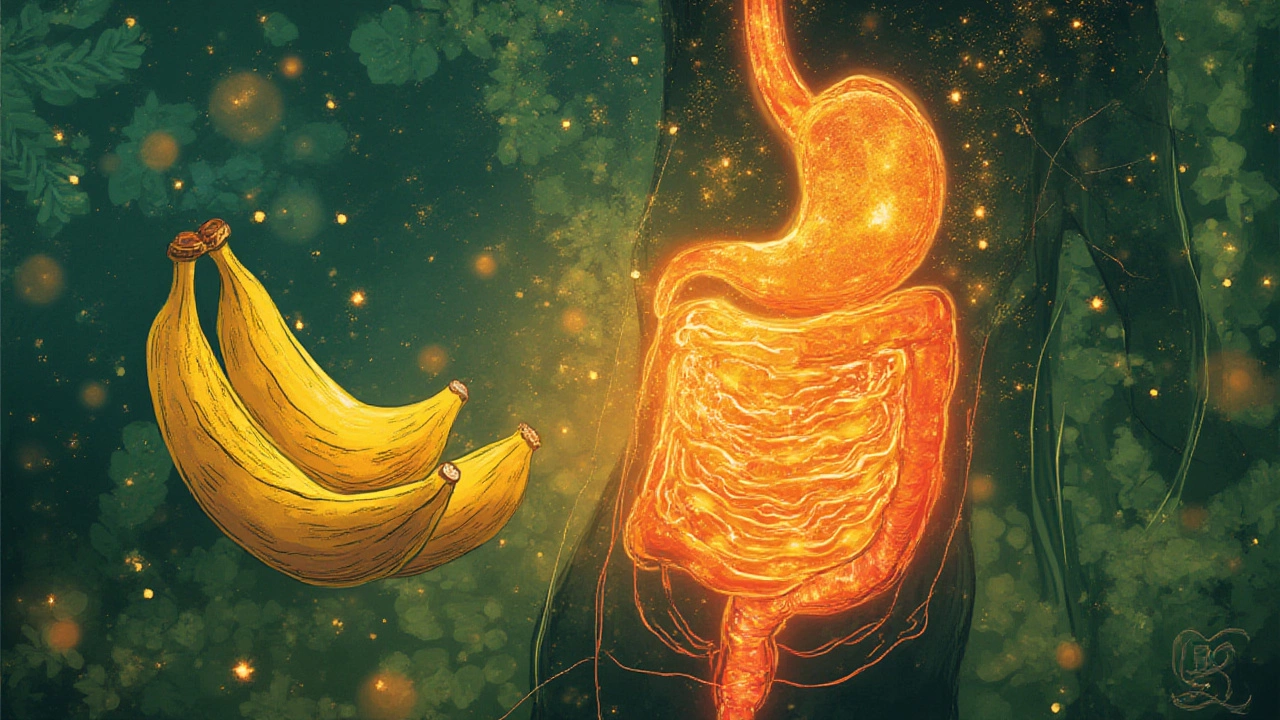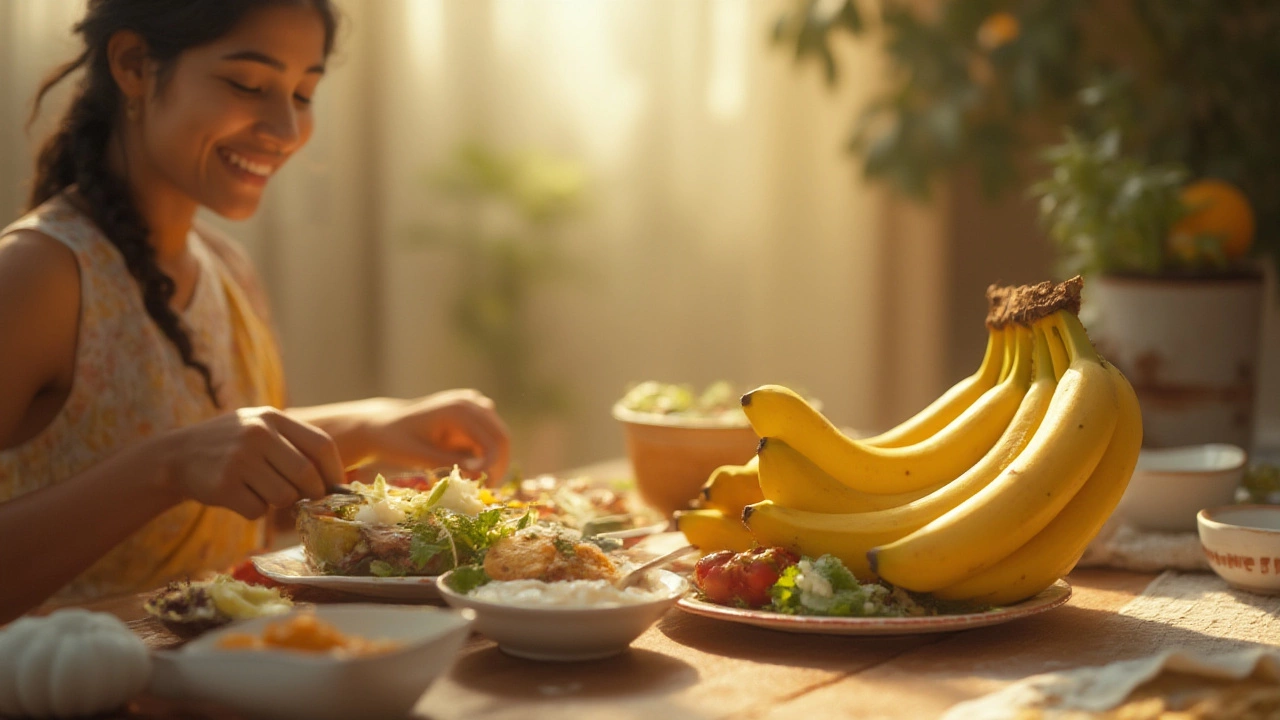Ever wonder why grandmothers and sports coaches obsess over bananas? It's not just the convenient peel or their natural sweetness, you know. It turns out bananas are basically superheroes for your gut. Most people think of yogurt when you mention 'gut health,' but bananas are just as important, if not more. They show up at breakfast tables and snack breaks with a secret stash of benefits that goes well beyond taste. With something as simple as a banana, you can be kind to your digestive system and give your whole body a boost.
What Makes Bananas So Good for Your Gut?
Let’s start with the basics. Bananas are loaded with fiber, which is the unsung hero of a happy digestive system. But not just any fiber. Bananas, especially when they’re still a little green, contain resistant starch—a type of fiber that doesn’t break down in the stomach and small intestine. Instead, it moves right along to your large intestine, where your good gut bacteria feast on it. So yes, bananas are basically throwing a party in your gut for your beneficial bacteria, and everyone’s invited.
These helpful bacteria turn resistant starch into short-chain fatty acids (SCFAs) like butyrate. Sound fancy? It actually matters a lot. Butyrate is like a multi-tool for your colon: it fights inflammation, keeps the colon lining healthy, and may even reduce the risk of certain diseases including colorectal cancer. You won’t see that on your regular grocery list.
The soluble fiber in bananas also helps regulate the speed at which food moves through your gut. This means less bloating and more regular bathroom trips. If you’ve ever been told to eat a banana after a tummy bug, this is why! Their soluble fiber can help solidify loose stools but also prevent constipation. It’s like they know exactly what your gut needs to get things back on track.
Bananas also have something rarely discussed: prebiotics. You hear about probiotics in things like kombucha or yogurt, which are actual good bacteria. But prebiotics are what those bacteria need in order to thrive. Green bananas in particular provide a big dose of prebiotic fiber, making them food for probiotics. This boosts your body’s natural defense system and helps balance your gut ecosystem.
If numbers matter to you, here’s a quick stat: A medium-sized banana offers about 3 grams of fiber, making up roughly 10% of your daily needs (based on a 30g-per-day recommendation). But the texture and ripeness of a banana has a big effect on what kind of fiber you get. Check out this comparison:
| Banana Ripeness | Resistant Starch | Sugar Content |
|---|---|---|
| Green / Unripe | High | Low |
| Spotted / Ripe | Low | High |
So, if you’re after gut benefits, toss a sliced green banana into your morning smoothie or overnight oats. It’ll be a little less sweet, but your gut will love you for it.

Bananas for Gut Troubles: Real Help or Just Hype?
Here’s where things get even more interesting. Bananas have a reputation for settling upset stomachs. If you grew up following the BRAT diet (bananas, rice, applesauce, toast) after a bout of the runs, you already know this. But there’s real science to back it up. The soluble fiber in bananas (called pectin) works like a gentle sponge, soaking up excess liquid in your intestines and helping you get things back to normal without any medicine. This has been confirmed by studies in children recovering from diarrhea, where bananas shortened recovery time and restored bowel regularity faster than bland rice alone.
But it’s just as useful when things slow down, too. If your digestion feels sluggish, the fiber in a banana can help jump-start things. Resistant starch and pectin act gently, encouraging wave-like muscular contractions called peristalsis. This helps food and waste move along smoothly. It’s a delicate nudge for your digestive tract—nothing like the panic-inducing rush from coffee—but just enough to keep things regular if you’re stuck in traffic (or stuck on the couch).
Now, if you’ve dealt with irritable bowel syndrome (IBS), bananas can be a mixed bag. Ripe bananas are higher in fermentable sugars called FODMAPs, which can cause bloating in some folks with sensitive guts. But the greener a banana, the less likely it will trigger symptoms. Some people with IBS actually find green bananas are gentle and even helpful, while fully ripe ones could cause trouble. If you’re not sure, try adding small amounts—and listen to your own body. No two guts are the same.
Beyond fiber, bananas bring potassium to the table—about 422 mg in a medium fruit. Potassium is essential when you’ve lost fluids from diarrhea or sweating. It helps balance fluids and supports muscle contractions (including those in your intestines), preventing uncomfortable cramps or irregularity. Bananas are an easy, tasty potassium fix when you need it most.
Oh, and don’t ignore the antioxidants. Bananas carry dopamine and vitamin C, fighting free radicals throughout your digestive tract. They’re not as loaded with antioxidants as berries, but every bit helps when you’re trying to calm down an inflamed or cranky gut.
So, is the banana a cure-all? Not really. But it delivers real results, both for tummy troubles and ongoing gut support. Unlike many so-called ‘superfoods’ that are tricky to source or expensive, bananas are cheap, available everywhere year-round, and don’t need any special prep—perfect for busy lives. The trick is choosing the ripeness level that suits your gut, and mixing things up to keep your digestion running at its best.

Smart Ways to Eat Bananas for Better Digestive Health
If you’re used to tossing a banana into your bag as a quick snack, great start! But if you really want gut perks, it helps to get creative. The fiber and resistant starch are most potent in green, slightly underripe bananas. But ripeness isn’t always everyone’s favorite flavor—so here are smart ways to work them in without making your morning miserable.
- Green bananas for your gut: Slice a firm green banana into your morning oats or yogurt bowl. Their mild, starchy taste is easy to mask with a drizzle of honey or a scoop of nut butter.
- Smoothie time: Toss a chunk of green banana into the blender with spinach, berries, and unsweetened yogurt. This gives you fiber, prebiotics, and a creamy texture—all without added sugar.
- Homemade banana chips: Slice green bananas thinly, spritz with coconut oil and a pinch of cinnamon, then air-fry or bake until crisp. Store them as a crunchy, portable snack with bonus gut benefits.
- Unripe banana curry: In South Indian kitchens, green bananas are chopped and cooked in fragrant curries. This not only keeps their resistant starch content high, but delivers big flavor.
- Bake with balance: Mashed ripe banana is fantastic for gut-friendly muffins or pancakes. Mix with oat flour and walnuts for extra fiber, and sprinkle with chia seeds to amp up the prebiotic effect.
- Combo tip: Pair bananas with plain Greek yogurt or kefir. The banana’s prebiotic fiber feeds the probiotics in yogurt—a one-two punch for your microbiome.
If you’re diabetic, you might worry about the sugar in ripe bananas. Good news: green and slightly yellow bananas have lower glycemic impact. And because their resistant starch isn’t digested in the small intestine, you might get slower, more stable energy instead of sharp spikes.
Here’s a little secret: banana peels are edible and packed with nutrients, including additional fiber for your gut. They’re not the tastiest raw, but boiled or baked peels can be blended into smoothies or stews. Don’t knock it till you try!
Want a mini science hack? When you cool cooked banana (think: in banana bread), the starches ‘retrograde’ and become more resistant to digestion—that means your leftover banana treats might be even better for your gut the next day. So don’t worry about making an extra batch or two.
And no, you don’t have to eat three bananas a day to see results. Studies in adults showed gut-friendly changes in bacteria and bowel habits with as little as one small banana daily for two weeks. The body loves small, consistent support. If you’re looking for better digestion, fewer tummy issues, or just a reliable snack with real science behind it, the humble banana is hard to beat.
